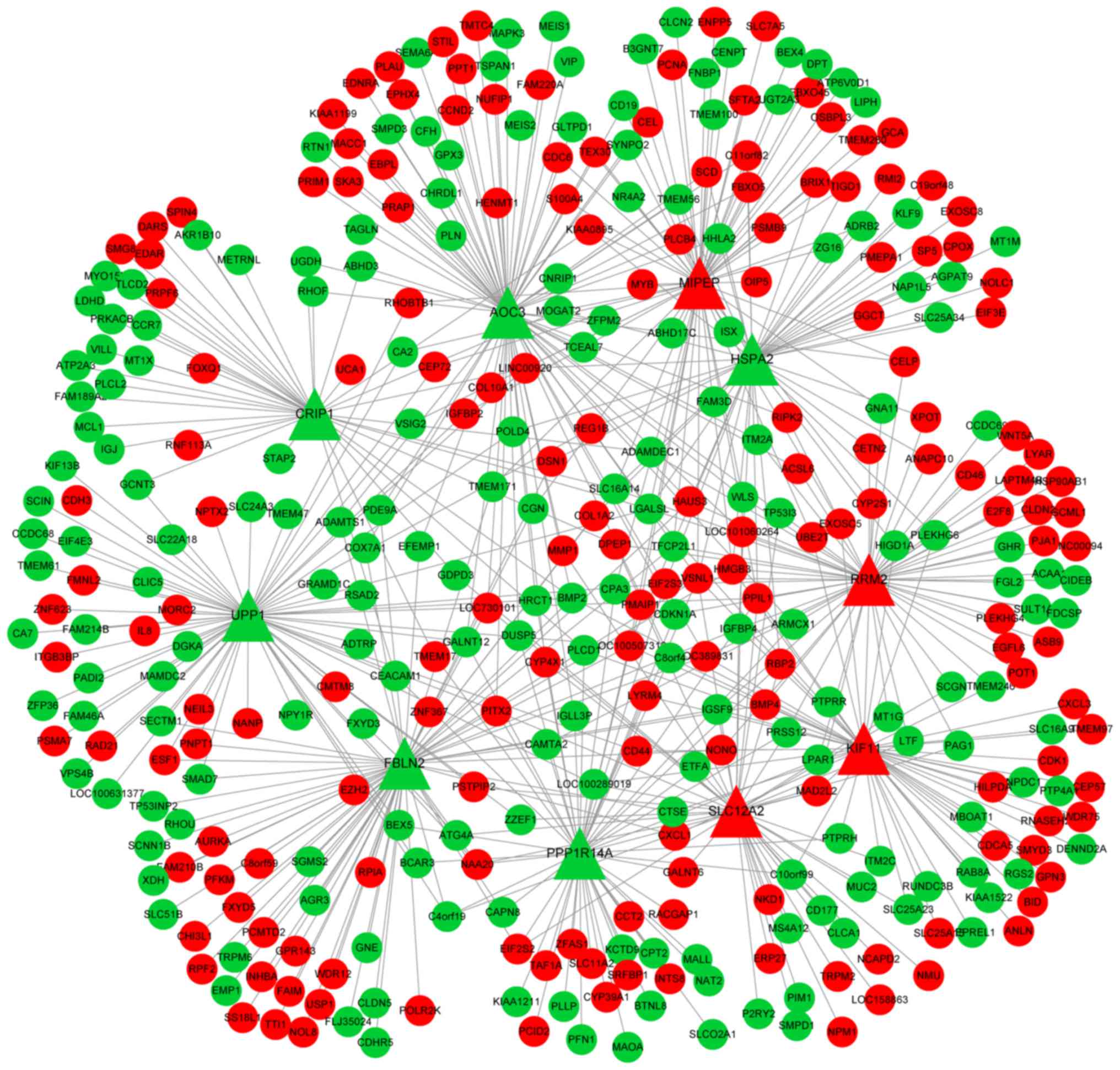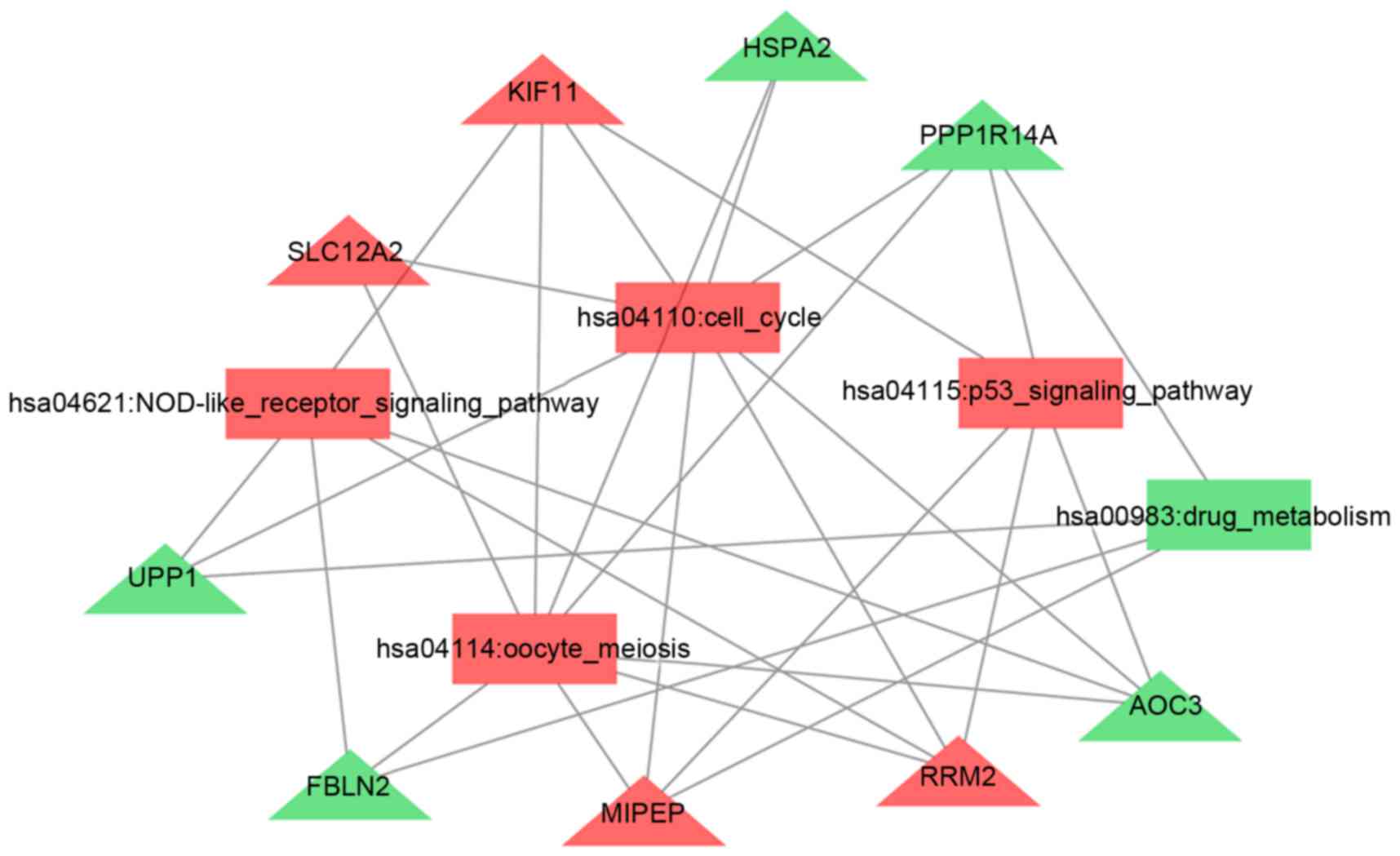|
1
|
Siegel R, Naishadham D and Jemal A: Cancer
statistics, 2013. CA Cancer J Clin. 63:11–30. 2013. View Article : Google Scholar : PubMed/NCBI
|
|
2
|
Jemal A, Ward E and Thun M: Declining
death rates reflect progress against cancer. PLoS One. 5:e95842010.
View Article : Google Scholar : PubMed/NCBI
|
|
3
|
Bender CM, Pao MM and Jones PA: Inhibition
of DNA methylation by 5-aza-2′-deoxycytidine suppresses the growth
of human tumor cell lines. Cancer Res. 58:95–101. 1998.PubMed/NCBI
|
|
4
|
Kim MS, Lee J and Sidransky D: DNA
methylation markers in colorectal cancer. Cancer Metastasis Rev.
29:181–206. 2010. View Article : Google Scholar : PubMed/NCBI
|
|
5
|
Luo Y, Wong CJ, Kaz AM, Dzieciatkowski S,
Carter KT, Morris SM, Wang J, Willis JE, Makar KW, Ulrich CM, et
al: Differences in DNA methylation signatures reveal multiple
pathways of progression from adenoma to colorectal cancer.
Gastroenterology. 147:418–429.e8. 2014. View Article : Google Scholar : PubMed/NCBI
|
|
6
|
Zitt M, Zitt M and Müller HM: DNA
methylation in colorectal cancer-impact on screening and therapy
monitoring modalities? Dis Markers. 23:51–71. 2007. View Article : Google Scholar : PubMed/NCBI
|
|
7
|
Takai N and Narahara H: Array-based
approaches for the identification of epigenetic silenced tumor
suppressor genes. Curr Genomics. 9:22–24. 2008. View Article : Google Scholar : PubMed/NCBI
|
|
8
|
Carmona FJ and Esteller M: Epigenomics of
human colon cancer. Mutat Res. 693:53–60. 2010. View Article : Google Scholar : PubMed/NCBI
|
|
9
|
Khamas A, Ishikawa T, Shimokawa K, Mogushi
K, Iida S, Ishiguro M, Mizushima H, Tanaka H, Uetake H and Sugihara
K: Screening for epigenetically masked genes in colorectal cancer
using 5-Aza-2′-deoxycytidine, microarray and gene expression
profile. Cancer Genomics Proteomics. 9:67–75. 2012.PubMed/NCBI
|
|
10
|
Gautier L, Cope L, Bolstad BM and Irizarry
RA: affy - analysis of Affymetrix GeneChip data at the probe level.
Bioinformatics. 20:307–315. 2004. View Article : Google Scholar : PubMed/NCBI
|
|
11
|
Smyth GK: Limma: Linear models for
microarray dataBioinformatics and computational biology solutions
using R and Bioconductor. Springer; New York, NY: pp. 397–420.
2005, View Article : Google Scholar
|
|
12
|
Meyer PE, Lafitte F and Bontempi G: Minet:
AR/Bioconductor package for inferring large transcriptional
networks using mutual information. BMC Bioinformatics. 9:4612008.
View Article : Google Scholar : PubMed/NCBI
|
|
13
|
Shannon P, Markiel A, Ozier O, Baliga NS,
Wang JT, Ramage D, Amin N, Schwikowski B and Ideker T: Cytoscape: A
software environment for integrated models of biomolecular
interaction networks. Genome Res. 13:2498–2504. 2003. View Article : Google Scholar : PubMed/NCBI
|
|
14
|
Treviño S III, Sun Y, Cooper TF and
Bassler KE: Robust detection of hierarchical communities from
Escherichia coli gene expression data. PLoS Comput Biol.
8:e10023912012. View Article : Google Scholar : PubMed/NCBI
|
|
15
|
da W Huang, Sherman BT and Lempicki RA:
Systematic and integrative analysis of large gene lists using DAVID
bioinformatics resources. Nat Protoc. 4:44–57. 2009.PubMed/NCBI
|
|
16
|
Benson AB III: Epidemiology, disease
progression, and economic burden of colorectal cancer. J Manag Care
Pharm. 13 6 Suppl C:S5–S18. 2007.PubMed/NCBI
|
|
17
|
Hill VK: Identification of DNA Methylation
Changes in Sporadic Breast and Other Cancers. University of
Birmingham; 2011
|
|
18
|
Jung N, Won JK, Kim BH, Suh KS, Jang JJ
and Kang GH: Pharmacological unmasking microarray approach-based
discovery of novel DNA methylation markers for hepatocellular
carcinoma. J Korean Med Sci. 27:594–604. 2012. View Article : Google Scholar : PubMed/NCBI
|
|
19
|
Olin AI, Mörgelin M, Sasaki T, Timpl R,
Heinegård D and Aspberg A: The proteoglycans aggrecan and Versican
form networks with fibulin-2 through their lectin domain binding. J
Biol Chem. 276:1253–1261. 2001. View Article : Google Scholar : PubMed/NCBI
|
|
20
|
Argraves WS, Greene LM, Cooley MA and
Gallagher WM: Fibulins: Physiological and disease perspectives.
EMBO Rep. 4:1127–1131. 2003. View Article : Google Scholar : PubMed/NCBI
|
|
21
|
de Vega S, Iwamoto T and Yamada Y:
Fibulins: Multiple roles in matrix structures and tissue functions.
Cell Mol Life Sci. 66:1890–1902. 2009. View Article : Google Scholar : PubMed/NCBI
|
|
22
|
Senapati S, Gnanapragassam VS, Moniaux N,
Momi N and Batra SK: Role of MUC4-NIDO domain in the MUC4-mediated
metastasis of pancreatic cancer cells. Oncogene. 31:3346–3356.
2012. View Article : Google Scholar : PubMed/NCBI
|
|
23
|
Law EW, Cheung AK, Kashuba VI, Pavlova TV,
Zabarovsky ER, Lung HL, Cheng Y, Chua D, Lai-Wan Kwong D, Tsao SW,
et al: Anti-angiogenic and tumor-suppressive roles of candidate
tumor-suppressor gene, Fibulin-2, in nasopharyngeal carcinoma.
Oncogene. 31:728–738. 2012. View Article : Google Scholar : PubMed/NCBI
|
|
24
|
Shuen WH and Lung ML: Fibulin-2 suppresses
tumor growth and angiogenesis through the inhibition of Erk1/2 and
p65 pathways in nasopharyngeal carcinoma. Proceedings of the AACR
104th Annual Meeting 2013. AACR. Washington, DC. pp. 43092013;
|
|
25
|
Fontanil T, Rúa S, Llamazares M,
Moncada-Pazos A, Quirós PM, García-Suárez O, Vega JA, Sasaki T,
Mohamedi Y, Esteban MM, et al: Interaction between the ADAMTS-12
metalloprotease and fibulin-2 induces tumor-suppressive effects in
breast cancer cells. Oncotarget. 5:1253–1264. 2014. View Article : Google Scholar : PubMed/NCBI
|
|
26
|
Dunwell TL, Hesson LB, Pavlova T,
Zabarovska V, Kashuba V, Catchpoole D, Chiaramonte R, Brini AT,
Griffiths M, Maher ER, et al: Epigenetic analysis of childhood
acute lymphoblastic leukemia. Epigenetics. 4:185–193. 2009.
View Article : Google Scholar : PubMed/NCBI
|
|
27
|
Hill VK, Hesson LB, Dansranjavin T, Dallol
A, Bieche I, Vacher S, Tommasi S, Dobbins T, Gentle D, Euhus D, et
al: Identification of 5 novel genes methylated in breast and other
epithelial cancers. Mol Cancer. 9:512010. View Article : Google Scholar : PubMed/NCBI
|
|
28
|
Eto M, Ohmori T, Suzuki M, Furuya K and
Morita F: A novel protein phosphatase-1 inhibitory protein
potentiated by protein kinase C. Isolation from porcine aorta media
and characterization. J Biochem. 118:1104–1107. 1995. View Article : Google Scholar : PubMed/NCBI
|
|
29
|
Ali D, Honne H, Danielsen S, Cekaite L,
Meling G, Rognum T, Lothe R and Lind G: 694 Identification of novel
epigenetic biomarkers in colorectal cancer, GLDC and PPP1R14A. Eur
J Cancer Suppl. 8:1752010. View Article : Google Scholar
|
|
30
|
Hollander MC, Zhan Q, Bae I and Fornace AJ
Jr: Mammalian GADD34, an apoptosis- and DNA damage-inducible gene.
J Biol Chem. 272:13731–13737. 1997. View Article : Google Scholar : PubMed/NCBI
|
|
31
|
Park JS, Yoon S Young, Kim JM, Yeom YI,
Kim YS and Kim NS: Identification of novel genes associated with
the response to 5-FU treatment in gastric cancer cell lines using a
cDNA microarray. Cancer Lett. 214:19–33. 2004. View Article : Google Scholar : PubMed/NCBI
|
|
32
|
Bethge N, Honne H, Hilden V, Trøen G,
Eknæs M, Liestøl K, Holte H, Delabie J, Smeland EB and Lind GE:
Identification of highly methylated genes across various types of
B-cell non-hodgkin lymphoma. PLoS One. 8:e796022013. View Article : Google Scholar : PubMed/NCBI
|
|
33
|
Sherr CJ and McCormick F: The RB and p53
pathways in cancer. Cancer cell. 2:103–112. 2002. View Article : Google Scholar : PubMed/NCBI
|
|
34
|
Hartwell LH and Kastan MB: Cell cycle
control and cancer. Science. 266:1821–1828. 1994. View Article : Google Scholar : PubMed/NCBI
|
|
35
|
Lin WW and Karin M: A cytokine-mediated
link between innate immunity, inflammation, and cancer. J Clin
Invest. 117:1175–1183. 2007. View
Article : Google Scholar : PubMed/NCBI
|











